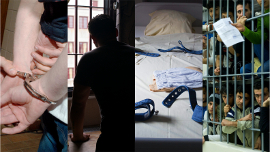The CPT received several complaints about excessive use of force by police officers at the time of apprehension and ill-treatment during police questioning (slaps, punches, kicks, kneeing and blows with batons). Moreover, the Committee’s delegation heard some accounts of verbal abuse, including of a racist nature, by police officers. The report also refers to a case of police ill-treatment which reportedly took place at Izsák Police Station (Bács-Kiskun County) on 8 April 2013 and which may well have led to the death of the detained person. In their response, the Hungarian authorities indicate that criminal proceedings concerning this case are pending.
During the visit, a number of remand prisoners were being held in police detention facilities, sometimes for prolonged periods. The CPT recommends, in the interest of the prevention of ill-treatment, that persons remanded in custody are promptly transferred to a prison establishment and are only returned to a police detention facility when there is absolutely no other alternative and for the shortest time possible.
Conditions of detention in police holding facilities were, on the whole, adequate for the duration of police custody (i.e. up to 72 hours). However, they were not adequate for remand prisoners held in these facilities for prolonged periods.
As regards prisons, the CPT’s delegation received no allegations of physical ill-treatment of prisoners by staff at Szeged Prison or at the Central Prison Hospital and the Unit for HIV-positive prisoners in Tököl; however, several allegations were received at Somogy County Remand Prison in Kaposvár and Sopronkőhida Prison. A number of accounts of verbal abuse of a racist nature and disrespectful remarks were also heard in the various establishments visited. Furthermore, in some of the establishments visited, inter-prisoner violence was an issue. The CPT also expresses serious misgivings about the effectiveness of investigations into complaints of ill-treatment by prison staff.
In the light of these findings, the CPT recommends that the national authorities redouble their efforts to combat ill-treatment by prison staff, review the system for investigating allegations of ill-treatment in order to make it more effective and protect the integrity of all prisoners, including against other inmates.
In their response, the Hungarian authorities state that the Head of the Hungarian Prison Service has instructed all law enforcement institutions to maintain good communication with prisoners, refrain from using any abusive or discriminatory language and remain vigilant with regard to these issues. Great emphasis is also being placed on the reduction of the level of inter-prisoner violence.
The CPT also expresses serious concerns about the lack of effective action to combat overcrowding (which has doubled since the 2009 visit and stood at 44% in 2013). By way of example, ten inmates were sharing a cell of some 27m² and a cell measuring only 5m² was accommodating two prisoners. The report also underlines the importance of policies designed to limit or moderate the number of persons sent to prison and of various non-custodial measures.
As regards the regime, many prisoners were still locked up in their cells for 23 hours a day, with little to occupy themselves. The CPT recommends that programmes of purposeful activities, tailored to the individual needs of the inmates, be further developed. In their response, the government indicates that particular importance is being paid to this issue, including development of training, education and employment, and refers to the recent significant increase in the employment rate of prisoners.
In previous visit reports, the CPT made critical remarks about the excessive use of means of restraint (hand-cuffs, ankle-cuffs and body-belts) in the context of movement of prisoners both within and outside the secure perimeter of a prison. The Committee approves of the decline in the use of these means observed during the 2013 visit; however, their regular application to certain groups of prisoners is still excessive in practice and a recommendation is made to further reduce their use.
The visit report and government response have been made public at the request of the Hungarian authorities and are available on the CPT's website: http://www.cpt.coe.int.
2014 News
The Council of Europe’s Committee for the Prevention of Torture and Inhuman or Degrading Treatment or Punishment (CPT) has published today the report on its periodic visit to Hungary in April 2013, together with the response of the Hungarian authorities.
30/04/2014
- Diminuer la taille du texte
- Augmenter la taille du texte
- Imprimer la page

Preventing torture in Europe
www.cpt.coe.int


